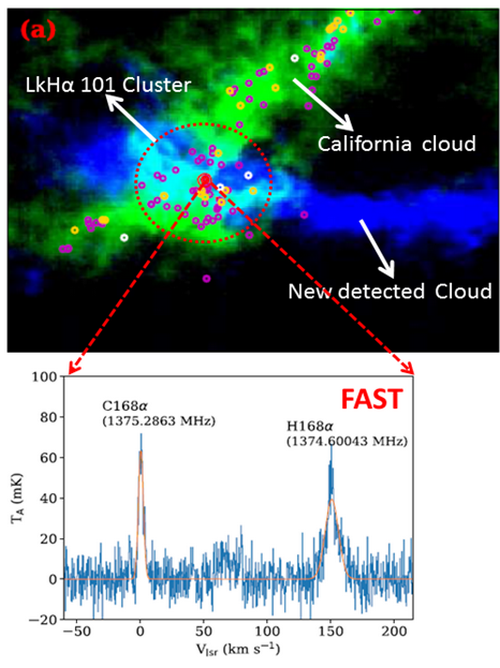Based on the observation data of the 13.7-meter millimeter wave telescope of Purple Mountain Observatory of CAS (PMO) and the FAST of National Astronomical Observatories of CAS (NAOC), and combined with the archive data of other wavebands, Dr. JinLong Xu from NAOC and other partners revealed that the first buried cluster in California is formed by dismemberment after being hit by another giant molecular cloud. The result was published on April.8 in the Astrophysical Journal Letters.
“Most of the stars in the universe form in the form of clusters, while the clusters are formed in the giant molecular cloud. After the parent molecular cloud is dispersed, the clusters visible in the optical band are left behind. In the early stage of evolution, the age of stars in clusters is very similar and they are almost formed at the same time, it requires a large number of gases to accumulate rapidly in the formation position of clusters,” said Dr. JinLong Xu.
In addition, the traditional model of astronomy suggested that the only reason for the formation of star clusters is the gravitational collapse of giant molecular clouds. But what event triggered the formation of star clusters? Especially in large-scale giant molecular clouds, more than one cluster can be formed, so how is the first cluster formed? And the formation of the first cluster will cause the formation of other stars and clusters in the whole giant molecular cloud like a spark, which are all the research topics of great concern in the astronomical field.
“The California giant molecular cloud is the largest in mass within 500 pc of our solar system, and it has similar shape and scale with the famous Orion A giant molecular cloud. However, at present, there is only one cluster (LKHα 101) and several B-type massive stars in California, and these B-type massive stars are also located in the cluster,” said Dr. JinLong Xu.
The team used the observation data of the PMO 13.7-meter millimeter wave telescope to observe the molecular spectrum of carbon monoxide (CO) at the cluster location, and found that a new fibrous giant cloud interacted with the California, and the cluster was located at the intersection of the two giant clouds.
At the same time, the research team used the FAST to observe the radio hydrogen (H) and carbon (c) RRLs in the HII region associated with the cluster, and ruled out the possibility that the cluster only overlaps with the cross position in the visual direction through the detected composite line system speed, so as to directly confirm that the first buried cluster in the California giant molecular cloud is dismembered after being hit by another giant cloud Form. The team concluded that the "kindling" of the first cluster in the giant molecular cloud may be caused by the impact of foreign gases. The results of this study will be used for reference in the study of the origin of clusters.

Figure. Upper: CO molecular gas distribution and cluster position; Below: the hydrogen (H) and carbon (c) RRLs from the FAST observation (Credit: Jinlong XU)
This paper can be accessed at https://doi.org/10.3847/2041-8213/ab830e

Address: 20A Datun Road, Chaoyang District, Beijing, China code: 100012
Tel: 010-64888708 E-mail: naoc@nao.cas.cn

